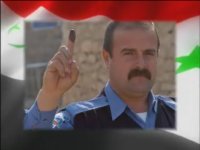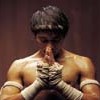Agam's Gecko


Sunday, September 30, 2007
POP MEDIA AND THE BURMA DEMOCRACY MOVEMENT
| W |
hat can CNN's Dan Rivers teach us about the freedom movement sweeping across Burma? Beats me.
There were protests and aspirations expressed on Saturday (while the wireservices, CNN, and most of the other professional reports were saying "streets are quiet today") -- from coastal Sittwe to central Mandalay, and Pakkoku to Moulmein. Even to the Shan mountains I'm sure, like the villagers in the photo (two articles below) showing solidarity for Burma's freedom.
Like these guys here in the photo, after three days of army killings, unbowed. They were fewer in number, only the brave ones; hundreds per demo on Saturday rather than the tens of thousands per demo on Wednesday and Thursday (not counting the monks, who were largely under guard or barricaded inside their monasteries yesterday, shouting freedom to the outside).
But the streets of Rangoon did echo with more protests on Saturday. Accounts of this did reach the outside world via foreign-based Burmese bloggers with inside contacts, exile Burmese media like DVB, Mizzima and Irrawaddy with more such contacts and their networks of clandestine citizen journalists in the country, and other patriots like the esteemed Ko Hla providing info from inside Burma at BurmaNews on Cbox (or see sidebar). Incidents were being described on these media and available to anyone, by late morning Saturday.
Yet the AP and others were still saying that no demonstrations were taking place, until practically nightfall. It was almost midnight over here (Rangoon is close, only half hour time difference) before CNN started saying that protests did take place. Late evening here, and they were breaking news that had happened many hours earlier (and was widely known many hours earlier, including on this blog). The above-mentioned citizen and exile media were reporting the "demos are continuing but with fewer participants" situation since midday. Even I, a slow composer, published a round up in the afternoon (after fitting up that Burma bulletin sidebar thingy). The narrative told by the big media continued to be, no protesters, lots of soldiers, everybody staying home today, it looks like the army has won (that last from AP) for quite a few hours after they could have known better, by just reading the internet stream.
After I posted "Demonstrations Continue" yesterday at 4:40 pm, I took The Best Dog in the World for his walk (his name is Bear), then we took a bike ride over to the Myanmar embassy. (Bear likes bike rides, taking a sphinx-like position in a backpack worn on my front). It was almost dusk, and only a couple of monks and few other people seemed to be waiting on the sidewalk. It'll be another candlelight vigil, I thought, we'll come back later.
Back to the office again, check latest word on Mizzima and Burmese bloggers, and Irrawaddy (by then operational again after the cyber attack), scan the photo-wires, find the second DVB video and post that, and then it's "Bear! Let's go for another bike ride!" He wore a red scarf, I a red shirt, and we brought candles this time. (The vigil was over, I'd waited too long.)
We ride back to the office, I do some more work, and we bike home about ten. It's my first chance to check what CNN is showing on the crisis since morning. "Streets are quiet in Rangoon, no protests so far today." The whole western media seemed to be at least 6 hours behind the curve, way behind the Burmese journalists.
Overnight CNN frequently introduced Dan Rivers to provide context and understanding of the Burmese freedom movement, since "our correspondent Dan Rivers has been inside the country, and knows....."
A year ago, Dan happened to be in Bangkok when the Sept. 19 coup happened. He was hugely annoying with his breathless excitement and garbling of Thai history. He seemed not to understand the Thai monarchy, and made a major reporting faux pas that could only be made by someone who didn't know much. I'm sorry, but I just don't think he's very good at this (though he hasn't been in Asia more than a couple of years, which isn't long). It's the overacting that really puts me off some of these infotainment journalists.
I'm sure Dan has probably been to Rangoon during his brief time in Asia, or I hope so anyway. But the fact that he went inside Burma since the violence began, means that he can share his understanding of the movement with CNN's viewers, right? Rivers went to Tachilek, a border town in eastern Burma. People can go there easily from northern Thailand, and are allowed visa-free entry to visit just for the day. He talks to people who tell him the whole crisis thing "doesn't really affect me at all," and who affect complete disinterest in the current events.
The Tachilek border has at times past been closed during periods of heightened conflict in eastern Burma, or tension between Burma and Thailand. It doesn't usually stay closed for very long. That it's still open for tourists now, shows that the junta has nothing to worry about there. It's been secured, and is quite isolated from the ethnic wars against the Shan and Karen in that region of Burma. There are an abundance of military intelligence people keeping an eye on things, and it's no wonder those interviewees were so non-committal about current events. Still, he did find and talk with a democracy-sympathetic person or two.
The Karen people were promised an independent Karen State following World War II, in recognition of their contribution as an ally against fascism. Britain didn't quite follow through on that, nor the other allies. So when the revered father of the Burma Army (Tatmadaw) and of independence itself, led the way to independence, Karen State was part of the confederation of states to be known as the Union of Burma.
The revered father of course was Aung San, father of Suu Kyi. Many people still keep his photograph on their walls, much like Indonesians still do with Sukarno. Father of the nation. Similar to what Thais do with portraits of HM the King, and Tibetans (when not risking punishment for it from Chinese authorities, or when safely in exile) do with Dalai Lama's image. A symbol of national identity.
Aung San was assassinated as he was about to become the first Prime Minister of Burma in 1947 -- Suu Kyi was two years old. The intrigue behind the assassination is still hotly debated today.
The dictatorship of Ne Win seized power in 1962, and soon drove the country to ruin. A highly superstitious old tyrant, he decreed things like reformulating the currency so that the denominations would add up to nine -- 45 kyat notes and 90 kyat notes, 35's to add to your 10's to make 45, stuff like that.
Burma was a mess under the one party rule of Ne Win's "Burma Socialist Programme Party -- going from one of the most prosperous in Asia to "least developed country" status. Ne Win resigned at the height of a popular uprising, warning citizens in his resignation speech that if the demonstrations continued, "the Army would shoot straight." They did, and demonstrators were slain in the streets by the thousands. The 8888 movement, the fighting peacock flag, August 8, 1988.
Continued protests against one party rule led the military to seize power the following month, finally crushing the uprising led by students and monks. It's generally believed that Ne Win orchestrated this coup from behind his curtain, and he continued to have influence on the new rulers -- the State Law and Order Restoration Council -- until the late 1990's. (He had a falling out with SLORC, was placed under house arrest in early 2002, and died under house arrest exactly nine months later, aged 92. He did love his nines.)
SLORC, under the previous chairman, allowed legitimate and fair elections in 1990 which Aung San Suu Kyi's National League for Democracy won by a landslide. Oops. Stall for time.
Than Shwe took over chairmanship in April 1992. Following him in the troika of big cheeses, Gen. Maung Aye, and until recently the military intelligence chief Gen. Khin Nyunt, who had contact with Suu Kyi and was purged by the other two in 2004. Than Shwe and Maung Aye are said to absolutely hate Daw Suu, whereas Khin Nyunt would meet with her. The junta was split, and Khin Nyunt was permitted to "retire for health reasons," immediately arrested, charged with corruption, and sentenced to a very lengthy term of prison. He may be serving it out under house arrest.
What kind of young fellows are shooting monks and citizens since Wednesday last? You might have noticed the "country boy" look to that soldier who stood over Kenji Nagai in the now famous photograph. No shoes.
This is no trained soldier. He might well be a forced conscript. He might have been shooting at Karen or Shan villagers a week ago. After the monks huge numbers -- over 100,000 in Rangoon alone -- some forces were reportedly brought back from eastern Burma to help suppress the uprising. These troops wouldn't have a clue what's going on except what they're told. Perfect. This Orwellian state knows exactly how to handle that problem. Prepare for re-grooving, soldier.
The authorities conscript them straight out of the movie theatres or round them up in the streets, thrust rifles into their hands and amphetamines down their throats, send them out to fight the KNU (Karen National Union), Shan State Army and other "destructive elements," chase and shoot at ordinary country people, relocate or destroy villages, conduct forced labour projects, have their way with Shan women projects, etc.
But back to Dan Rivers, who has been to a tourist-friendly border town in Shan State. So his network can boast that "our reporter has been inside the country, and knows..."
Knows what? How to explain at length how he really has no idea what's going on in Rangoon, Mandalay, Sittwe, Moulmein and other towns spread over more than half the country? How most folks he met in Tachilek told him they couldn't care less? That'll really help viewers understand the democracy uprising in Burma.
Labels: Burma











 Our way of saying "thanks" in the Thai way. Here a nak muay Thai (kickboxer) offers respect and thanks for his teacher (wai khru) before a match. This is our local variation on the ubiquitous "hat tip" used in general blog culture.
Our way of saying "thanks" in the Thai way. Here a nak muay Thai (kickboxer) offers respect and thanks for his teacher (wai khru) before a match. This is our local variation on the ubiquitous "hat tip" used in general blog culture.






